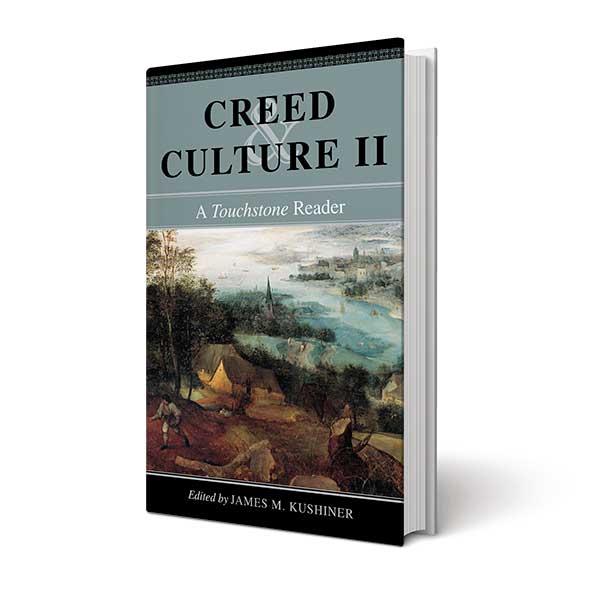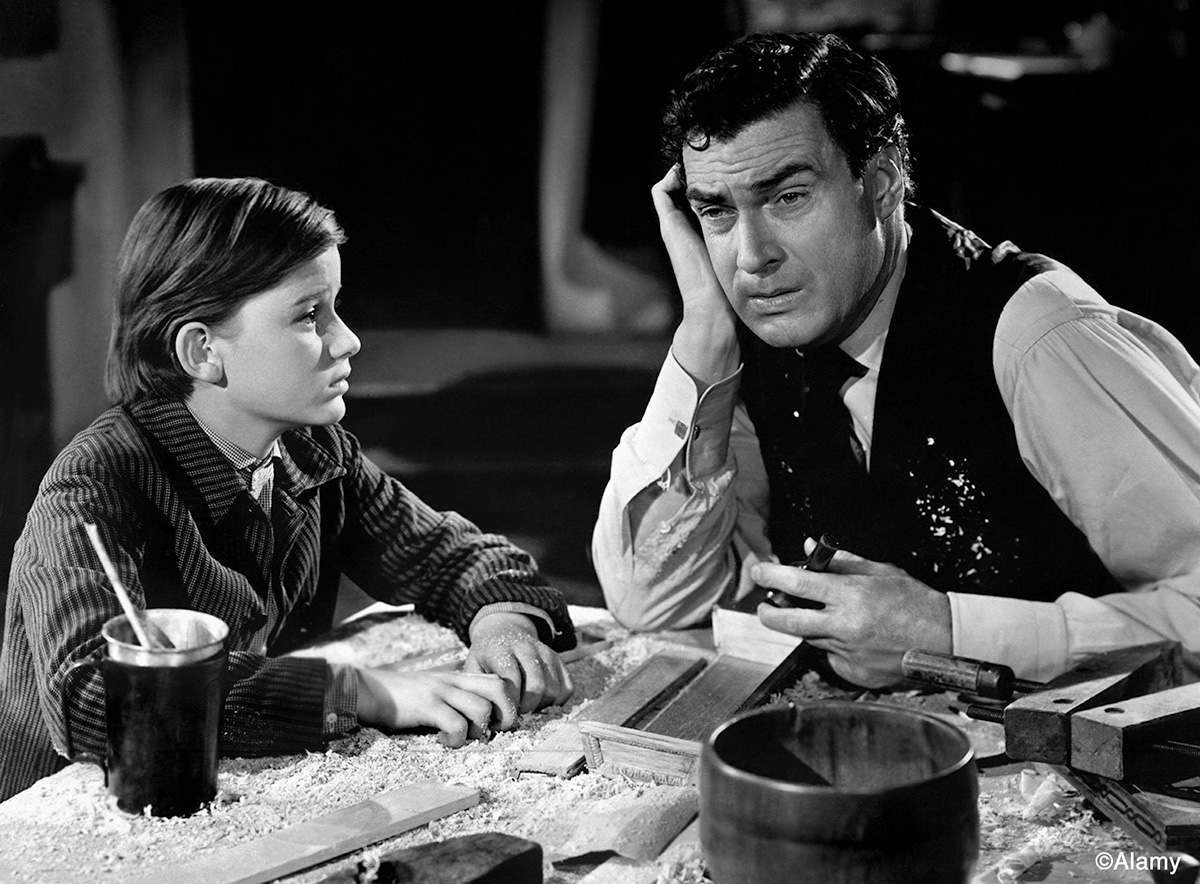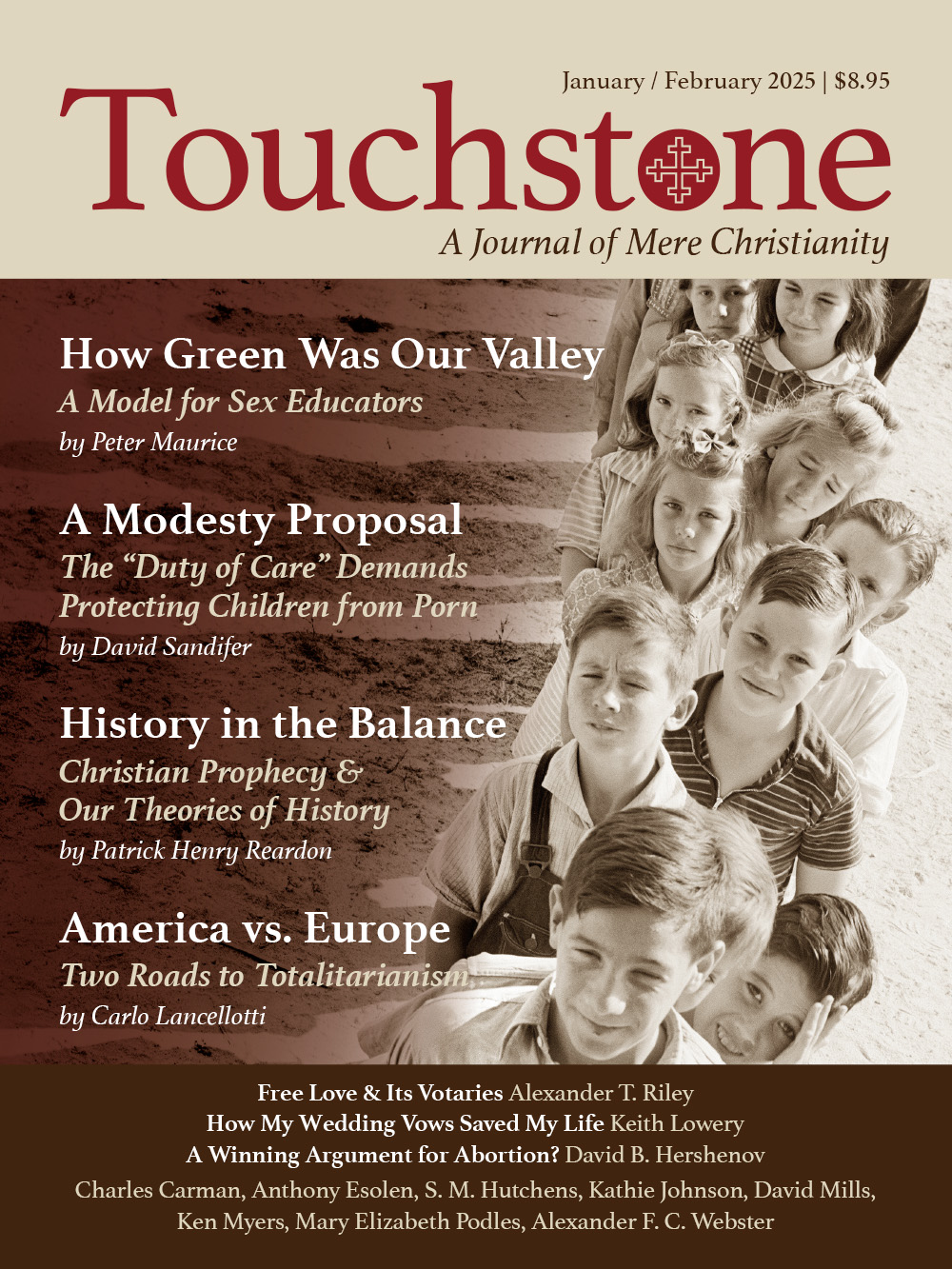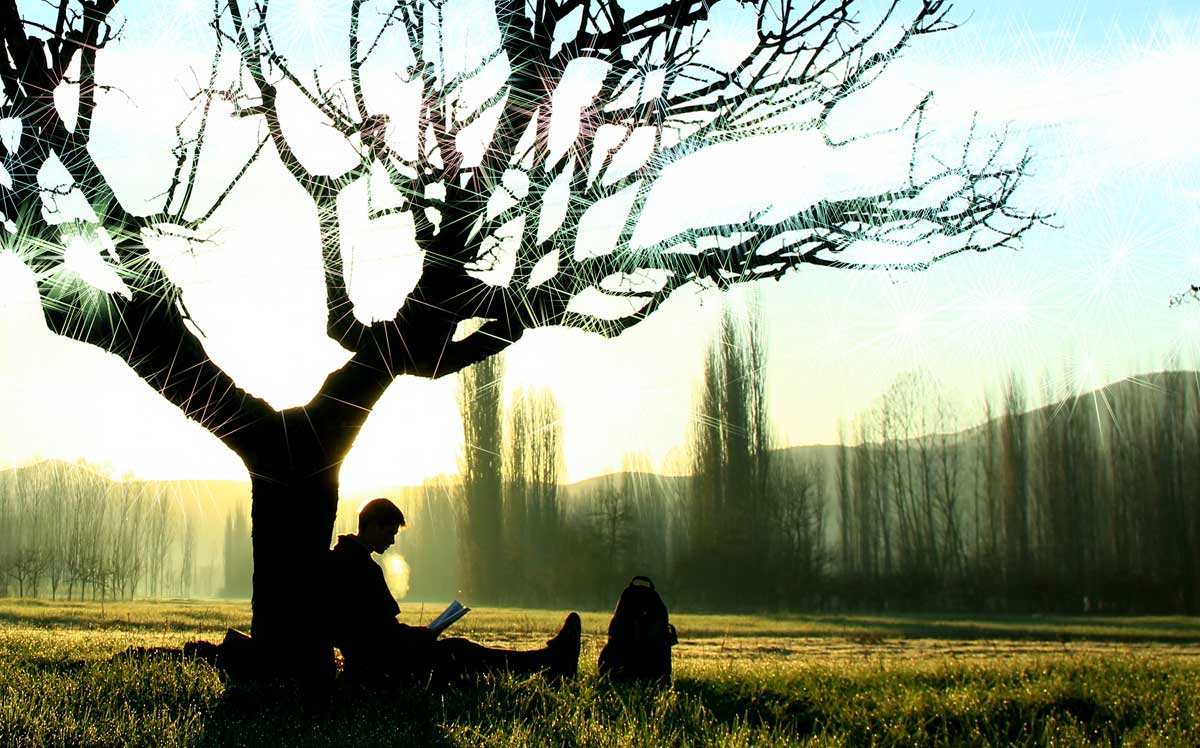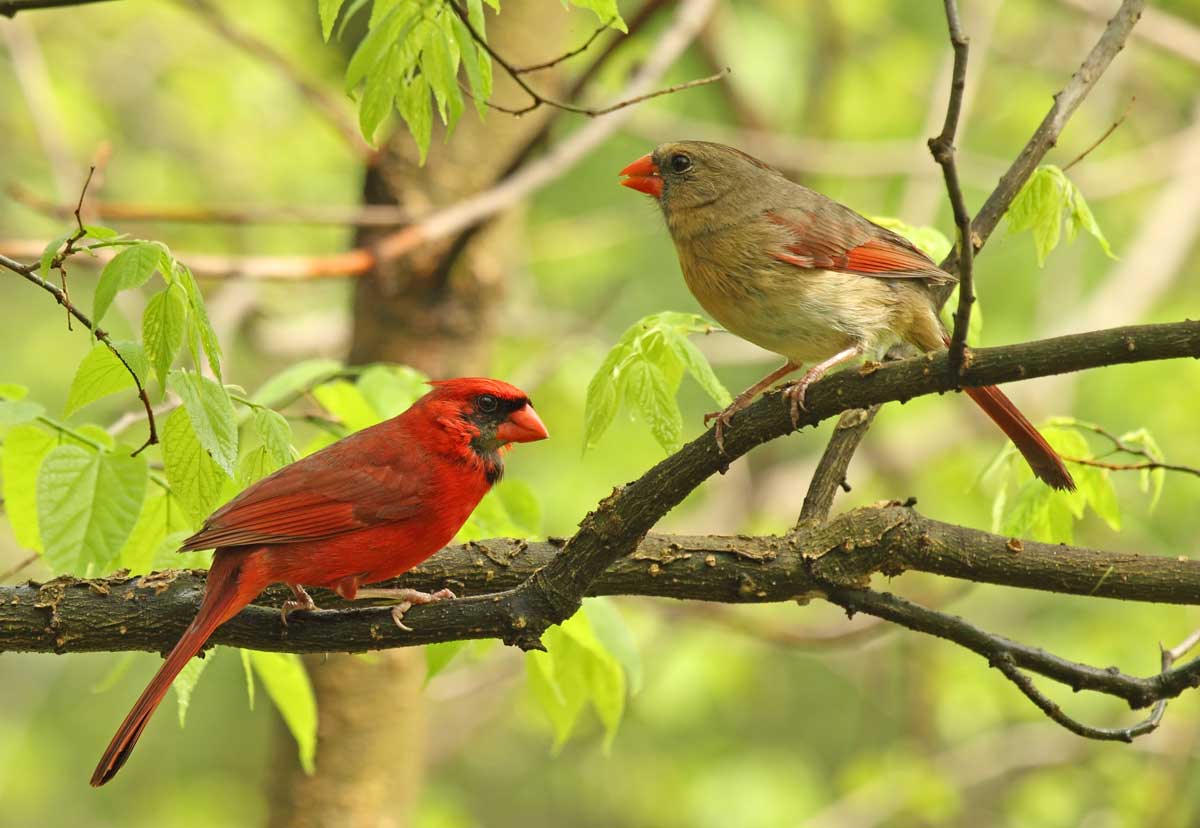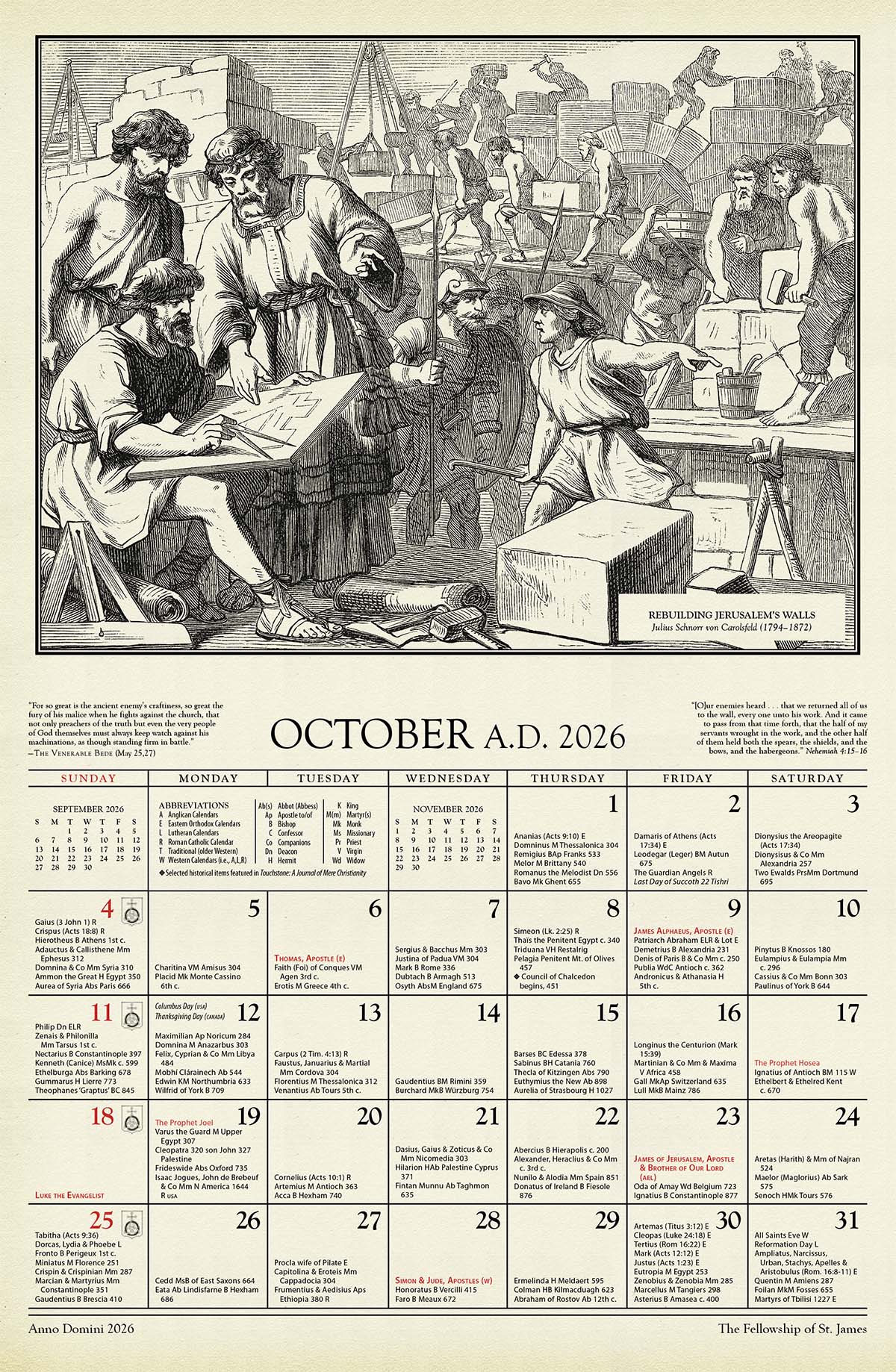How Green Was Our Valley
A Model for Sex Educators
Adults with a penchant for talking to children about the intimate relations of man and woman, let alone man and man, used to risk ostracism if not incarceration. But such talk has become a required “subject” in public schools.
And now, in most parochial schools. Without the excuse of a government mandate, they’ve done this themselves. In New Creation, the most popular sex-ed series in parochial schools, first-graders are taught that a boy has a penis between his legs, a girl a vulva; teachers help them retain this lesson with drawings. Fourth-graders learn the mechanics of sexual intercourse, enlivened by “appropriate” illustrations. In sixth grade, they learn about “spurts” called “ejaculations.” By eighth grade, boys “chart” the times and frequency of their erections, while girls note the “wettest feelings of the day.” Unfortunately, these examples typify rather than magnify the grossness of these programs. If they differ from their public-school models, it is in pro forma references to Jesus and Mary, and “God’s plan” for sexuality.
Dietrich von Hildebrand, echoing unanimous papal encyclicals and decrees up until the dawn of the present century, condemned the perversion of non-parental sex education. Premature knowledge would damage “the holy bashfulness of children.” How mystifying such a phrase would be to a modern sex educationist. Perhaps the philosopher was ignorant of Freud’s discovery: even from infancy, it’s all about sex.
Before woke psychology invented the child’s right to know everything, various myths were deployed in deference to what the folk perceived—like von Hildebrand—as childhood innocence. In Germany, “Der Kindlbringer,” a merry old gentleman much like Santa, transported the new baby in a sack. Water sprites, in some Nordic lands, carried the newborn to expectant parents (invariably a man and a woman). Across much of Europe, a variety of furry or feathered creatures performed this service. In America, despite some local variations, the stork was the deliverer par excellence.
A Model of Delicacy
There comes a time, however, when a child will no longer be put off with charming fables. Christian societies, until yesterday, then entrusted the transmission of the mystery of birth and sex to those who knew and loved the child best—the parents, or their designee.
Richard Llewellyn’s How Green Was My Valley offers a fine model (definition for sex educators: something to copy, to imitate) of the delicacy with which this could be done. Huw, the novel’s first-person narrator, is the youngest son in a family of Welsh miners. One evening, after overhearing the men use a bawdy reference, the boy asks his older brother to elucidate. Elder brother is brusquely evasive. Huw is too young to be asking such questions. Huw’s sister-in-law, Bronwen, likewise refuses to satisfy his curiosity, but sensing the burgeoning sexuality in the boy and the urgency of his need, she assigns the task to a trusted minister and family intimate, Mr. Gruffydd.
When Huw turns to him, the minister isn’t, in the mode of the modern sexpert, avid. He performs dutifully, abjuring the “wares peddled in the thoroughfares” of the co-ed classroom. He tailors his “lesson” for the unique soul of one sensitive young boy, a future husband and father, a transmitter in his turn, of this God-ordained role so vital to a Christian civilization. His approach might be called—in the cant phrase of the professional educator—“individualized instruction.”
Mr. Gruffydd leads the boy from what he already knows—the Genesis story of Adam and Eve—to what he might infer, mainly through Socratic questioning. The dialogue takes a subtly developed eight pages in Llewellyn’s novel. Though worth quoting in its entirety, we’ll make do with a sample:
“Now as to the union,” Mr. Gruffydd said, in another voice, as he would point the difference between two pieces of wood. “You have heard of the seed of man, Huw?”
“Yes, sir,” I said.
“Good,” he said. “There is wheat, and barley, and corn. All seed. And you must sow to reap, is it?”
“Yes, sir,” I said.
“So to have the baby in shape, there must be sown, first of all, the seed of man,” said Mr. Gruffydd.
“And it is sown in the womb. That is why men and women marry. Marriage is the union. Do you sow wheat out of season? Would you put seeds to earth in snow?”
“No, sir,” I said.
“No,” he said, “or you would be clapped in the madhouse, quick. There is a time and a season for all things. And the time of sowing the seed of man is at the time of marriage, not before. Never mind how impatient the farmer is to have a field of growing corn, he must wait for the season to sow, is it?”
“Yes, sir,” I said.
“Yes,” he said, “or be known for witlessness. So with man, Huw. The time of marriage is the time of sowing.”
Mr. Gruffydd doesn’t debunk or demystify. Respecting Huw’s bashfulness, he goes about his business of smoothing a tabletop as they converse, looking to his carpentry rather than boring into the boy. His lesson makes clear that sexual relations between man and woman are not to be compared to the couplings of animals, with no fore- or afterthought. Man, God’s only rational creature, must apprehend the nobility of his role as a bringer-to-be of future beings, also accountable to their creator. But ripeness is all, and the season for bringing a new soul into the world is after marriage.
Not Coming Back
In my admittedly limited exposure to the modern sex educator, I still see clearly that Mr. Gruffydd’s delicacy is not the go-to model. In the late 1970s, fresh from having reverted to Catholicism, my wife and I attended a back-to-school meeting for parents and teachers. This school cafeteria assembly was conducted by the nun-principal and a sex-education expert from the archdiocese of St. Louis.
After passing out registration material and giving instructions about uniforms, schedules, and the like, Sister was eager to broach the special topic of the evening—a new sex-ed program for the grade-school children. She then introduced the coordinator/facilitator/consultant of the program—her exact title and that of her program are lost to my notes. Let’s call her Ms. J, and her program The Wonder of You.
To most parents today, after more than a decade of exposure to sex-ed pornography in school libraries and curricula, Ms. J’s talk would seem anodyne. Back then, however, a lady breezily discussing the “intimate sphere” to an audience of parents (some with mercifully distracted children) was something of a novelty. Not everyone would feel comfortable with her frankness, but the culture had moved on, and she was there to help us confront—embrace might be the mot juste—this new reality.
In our culture, she explained, sex was everywhere—in movies, magazines, TV. Even on school playgrounds. Children were aware of these things before they could read.
I couldn’t help wondering if such awareness might have postponed their receptivity to print-laden books as less stimulating. As recent school board controversies have shown, school libraries now include a genre that the book-averse, non-print-oriented student might find more user-friendly, especially when adorned with graphics. Perhaps you have heard of these popular works, all culled from Steph Auteri’s Book Riot reviewentitled “These Frequently Banned Sex Ed Books Are Essential Reading in My Home.” Here’s a sampling, along with his/her blurbs: Gender Queer, “with lessons our kids really need more of in their lives”; Snapdragon, a graphic novel“which stealth-teaches empathy” for an “androgynous older lesbian” and other “multiple identities”; and, since kids like cartoon animals, And Tango Makes Three, featuring two cute same-sex-attracted penguins.
My guess is that Ms. J would not have endorsed any of these advanced perversions. Her heteronormative message was simply that modern Catholic children were not as insulated as their parents and grandparents had been “in the age of Leave It to Beaver. That age isn’t coming back.”
A long pause allowed her verdict to penetrate even the most reactionary souls in the cafeteria. But did anyone in this Catholic audience look back to the Age of Beaver with deep nostalgia? It’s true that Wally and the Beave obeyed their parents and didn’t do drugs, sport nose rings, or stash Playboy under their beds. Still, I couldn’t remember the Cleaver boys attributing their nice behavior to God or Christian doctrine. Anyway, we could agree: that simpler age was not coming back.
The Age of Accuracy
And therefore?
It had become the duty of Catholic educators to counter unchristian and misleading notions with Christian, but accurate, information.
This was the golden age of “accurate” information. The oddly simian visages of Masters and Johnson had graced the cover of Time (1970). They were even more famous for the accuracy of their sex research than pathfinder Kinsey, also a Time cover laureate (1953). And like their precursor, they scrutinized human sexuality with the precision of jungle ethologists measuring a bonobo’s jerks and thrusts in reaction to stimuli. They were blazing trails undreamt of by old-fashioned Freudians, mere babblers who talked to patients about their sex lives. Like pioneer Kinsey, Masters and Johnson filmed their specimens during intercourse and self-stimulation.
Aside from the romantic objection that what the sexperts call “accuracy” tends to obliterate eros, it seems hardly scientific to treat humans as more natural than it is natural to be. As with Kinsey’s pedophiles, prostitutes, and convicts, the Masters and Johnson volunteers could hardly have typified our species. Only a rara avis would, or could, perform on cue for the camera. Despite the “scientific” brag, one suspects a symbiosis—unholy and unscientific—of exhibitionist volunteers and voyeuristic researchers. As pronouncements during the Covid pandemic reminded us, it’s not always smart just to swallow the science.
But to get back to Ms. J. She was not plagued by bashfulness, holy or otherwise. The God-created human body and its sexual expression should be celebrated, not cloaked in shame. Her self-assured demeanor reinforced the verbal message.
Clearly, Ms. J wasn’t a Reverend Gruffydd, shouldering a burden that a crass culture had thrust upon her. She was an enthusiast of the new candidness.
The floor was then opened for questions.
Most centered around the threat to modesty and chastity. Group presentations would perforce ignore the disparity in curiosity, maturity, innocence. Who but a parent could judge readiness?
As a parent who was transferring, in part because of the sex ed in the public school, I felt obliged to second the naysayers. Like them, my wife and I assumed that St. X offered “a refuge” from the perverse experiments of the government conditioning centers.
Ms. J was horribly diplomatic. She respected the objections of the timorous. She understood our fears, and why “some might see the Catholic schools as a refuge, but. . . . ” My use of that unfortunate word exposed prudery cowering from reality.
Sister then rose and took the mic from the sexpert. Ms. J had warned her that some folks would feel “threatened by change.” But Sister had a playground anecdote that might persuade us—the uptight contingent—of the necessity of sex ed. Sitting near her office window at the end of last school year, she had overheard a “birds and bees” conversation between two third-grade girls. Little Anna had asked little Katie if she knew how babies came into the world. Anna explained that adults had relations, but the word she used was different. “They f****d.”
A few parents laughed. Most were silent and uncomfortable. Sister, pleased with having breached a barrier—that’s what pioneers do—said: “I can’t believe that I just used the ‘F’ word in public. But I’m glad I did. I think that shows why we need The Wonder of You at St. X.”
The minister in How Green Was My Valley treaded softly, lest he trample the green shoot of sexual awareness emerging in a boy he knew well through intimacy with his family. The promo of Sister and her sexpert betrayed no such hesitancy. Just like Dr. Schweitzer, who had introduced modern medicine and reverence for life along the banks of the Ogooué River, they bore the gospel of openness to the inhibited of St. X.
Diverted Course
Little did my wife and I suspect that that evening would divert the course of our lives (and provide further encounters with the sex-ed professionals), but so it happened.
A week later, we were sitting in our kitchen, enjoying conversation with our new friends, a couple who had also attended the meeting. One of their boys would be in the fifth grade with my son. And like us, they would sign a form reprieving him from The Wonder of You.
When a priest let himself in the back door, we assumed he had been invited by our friends. But it was the priest’s sister, also present at the meeting, who suggested he visit us with a job proposal. Would we like to take over a two-room grade school in the wilds of Franklin County? My wife had quit her job as editor for a textbook company to stay home with our two-year-old. She had no desire, as Chesterton said, to become something to everyone rather than everything to someone.
Three visits later, we reluctantly agreed to drive out to the school and erstwhile convent that would serve as home for the next ten years. My wife was first drawn to accept because this could be a real Catholic school, with no silly or sordid novelties. Being on the western rim of the archdiocese, remote from the education bureaucracy in St. Louis, we would design the curriculum. My wife, a fine calligrapher, lettered and framed a quotation from Jane Austen that would hang in the hall of our school as a caution against any itch of avant-gardism: “Mrs. Goddard was mistress of a school—not of a seminary, or an establishment, or anything which professed, in long sentences of refined nonsense, to combine liberal acquirements with elegant morality, upon new principles and new systems.” This was as close as we ever got to composing a mission statement.
When it comes to the mirage of earthly bliss, I’ve always liked Robert Frost’s mordant “Answer” to a young idealist: “But Islands of the Blessèd? Bless you, son, / I never came upon a blessèd one.”
No, our little school wasn’t paradise. Yet no visitor would have taken it for a typical public institution. There was no need to patrol or surveil at recess or lunchtime, periods of maximum mischief in schools. I can recall only one “property crime” in ten years.
A pair of glazed leaden busts of Dante and Beatrice stood as encyclopedia bookends. At lunch one day in Big Room, a fifth-grade girl cracked a walnut with the poet’s nose, transforming the Florentine profile from aquiline to pug. There was no need to punish, her tearful face being eloquent of regret.
Lest references to the accomplishments of our students smack of touched-up nostalgia or self-praise, I should acknowledge that the shortcomings of our faculty of two were supplemented by volunteer parents and older siblings. Many large and talented families in this rural community played musical instruments and sang for their own (and our) pleasure. They coached our student choir and shored up our constraints of time and talent in many ways.
There was also provision for fun, the kind that would have evoked Mr. Gradgrind’s scowl: archery contests against hay bales, fencing exhibitions, recess softball games—sometimes stretched by a participating teacher in order to finish an inning—and evening dismissal with prayers in French or Spanish, languages taught in grades five through eight. Not quite an isle of the blessed, but perhaps an atoll.
An Intolerable Negligence
Of course we did without The Wonder of You, a dereliction intolerable to Ms. K, the regional high-school sexpert. Sex ed was not optional in what she rapaciously termed the “feeder schools.” As the principal of one such school, I was summoned to her meeting. Different programs were being used in the feeders, she complained, which meant she couldn’t build on a “shared knowledge base.” There was a yet deeper negligence—one school had no sex ed at all! Since the delinquent’s name hadn’t been pronounced, I hung fire, resolved to skulk away as before.
Again, the zeal was electric. But was her enthusiasm shared? I could imagine two possible student reactions to Ms. K as she demystified the intimate sphere with her charts, texts, and visual aids: unhealthy stimulation, or—and I think this more likely—distaste and boredom.
Why certain adults have this avidity for talking about sex to other people’s children, I can only guess. What I can say is that they usually come across as too ready to adapt and, truth be told, a bit louche, not the first names you’d call for a babysitter.
A More Positive Approach
Whatever else they achieve, these classroom dispensaries of accurate information ignore a strange and pervasive crisis among youth—ambivalence about their God-ordained sexual nature. Boys and girls no longer find one another fascinating. This crisis is alarmingly visible in the faces and demeanor of the young. Every age, said Baudelaire, has its characteristic portrait, its mien, its gait. Our “portrait of youth” would have to feature a tech-neck slouch, averted eyes, and a dumb reluctance—indeed, an incapacity—to engage in conversation. The young seem to need a buffer—like the omnipresent smartphone—against unbearable reality.
Even the most vigilant Christian schools won’t eradicate all of the contributing features behind this calamity. But they should offer an alternative to, rather than be a reflection of, the ambient anti-culture, of which classroom sex ed forms a part. Students nourished on the beauty of great literature and art will have diminished appetites for the linguicidal wailings of anti-music, the concussive sounds and garish sights of blockbuster movies, the quasi-diabolical entertainments that accompany sports spectaculars—and pornography (that erstwhile resort of impotent “dirty old men”).
Christian teachers will pity the crabbed and senile pessimism that now makes a phrase like “youthful exuberance” sound so quaint. Unloading a dumpster of facts and statistics of decline or calling attention to its unlovely features (as in my preceding paragraph) will only appeal to a few precocious Jeremiahs. Most of the depressed and anxious young need a more positive approach.
Clearly, they won’t find it in government schools. They are no longer corrigible to moral reasoning and must be left to their own urges. But Christian schools can rethink a failed enterprise. The naturalistic basis on which sex education was marketed—the reduction of STDs, teen pregnancies, abortions, etc., has proved utterly fanciful. Its main contribution has been other than advertised: the near-extinction of the Christian, indeed, of the human, sentiment of sex.
Teachers who have the good of their students at heart will abandon the “accurate” and “scientific” boast. The mechanics of sex, the encounter of a male with a female gamete in a fertilization event, is a drama best left in the biology department, where it won’t be taken for the final word or confused with metaphysical reality. Models for deeper discussion will be found in the inexhaustible treasure house of imaginative literature.
I started this foray into the bleak house of contemporary miseducation with a reference to literary prototypes. The humanizing sentiment of sex has been dramatized in the oral and literary tradition, from Homer to Shakespeare, from Jane Austen to Richard Llewellyn. It has provided models over an enormous arc of human history, in song and in poetry, even modern poetry:
Forget the rest, my heart is true,
And in its waking thought of you
Makes the same wild and sudden leap
That jerks it from the brink of sleep.
These rhymes by Robert Graves may not rank with the romantic comedies of Shakespeare or the sonnets of Keats. But they should conjure, if not an experience, then an intimation, a “wild surmise” in the imagination of a vital and hopeful youth. Today, this intimation is blocked on many fronts. The Christian school has no excuse for being one of them.
Peter Maurice is a retired teacher of French, English, and humanities, at all levels from elementary through university. He is the recipient of several fellowships from the National Endowment for the Humanities. His writing has appeared in The Wanderer, Chronicles, Touchstone, Crisis, New Oxford Review, and Gilbert magazines.
subscription options
Order
Print/Online Subscription
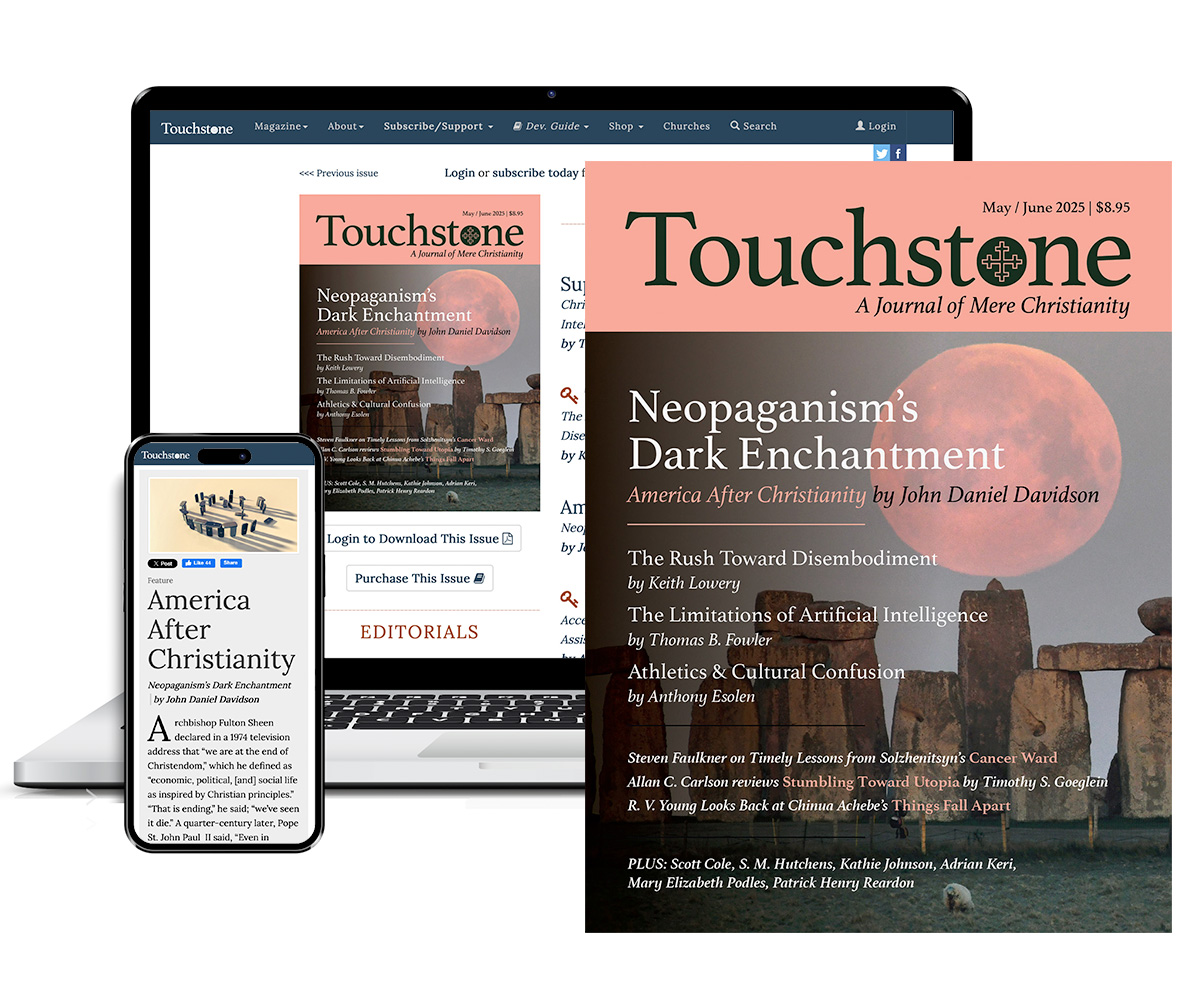
Get six issues (one year) of Touchstone PLUS full online access including pdf downloads for only $39.95. That's only $3.34 per month!
Order
Online Only
Subscription

Get a one-year full-access subscription to the Touchstone online archives for only $19.95. That's only $1.66 per month!
bulk subscriptions
Order Touchstone subscriptions in bulk and save $10 per sub! Each subscription includes 6 issues of Touchstone plus full online access to touchstonemag.com—including archives, videos, and pdf downloads of recent issues for only $29.95 each! Great for churches or study groups.
Transactions will be processed on a secure server.
more on education from the online archives
more from the online archives
calling all readers
Please Donate
"There are magazines worth reading but few worth saving . . . Touchstone is just such a magazine."
—Alice von Hildebrand
"Here we do not concede one square millimeter of territory to falsehood, folly, contemporary sentimentality, or fashion. We speak the truth, and let God be our judge. . . . Touchstone is the one committedly Christian conservative journal."
—Anthony Esolen, Touchstone senior editor




